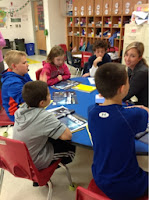However, probably one noteworthy "ah-ha" we was that 4th and 5th graders have anywhere from 110 - 150 minutes of literacy instruction per day. Then, students come to 6th grade and have 50 minutes of literacy instruction in ELA classes. That's a huge difference and the reason we stress literacy across the content areas so thoroughly.
Adding literacy instruction to all classes isn't about helping ELA teachers, it's about helping students sustain and develop literacy over time. The pictures below come with tips that all content-area teachers can use to provide instruction to students.
In the pictures above, teachers are providing guided reading instruction with students. In each reading group, the focus is non-fiction skills. Some groups are reading social studies texts (during social studies instructional time) and some are reading science texts. Teachers are reviewing text features and comprehension with summary and sequencing strategies. This is something that all content-area teachers could do. When students read in your classroom, pull a small group to provide some direct instruction and build their content-area comprehension.
 |
| Here is one of the strategies teachers used with non-fiction comprehension. |
Conferencing with students can come in many forms, sometimes it's one-on-one as the charts above show through documentation of student progress over time. Sometimes, it's in small groups to enhance a specific skill. The pictures below shows a student briefly conferencing with a teacher demonstrating their self-monitoring skills. The book being read is an independent choice novel, but the student has to apply their skills to this book.
Setting up the classroom to reinforce reading skills provides students with ongoing tools and reminders for thinking while reading. What makes these even more powerful is that students help to design this "classroom art."
Holding students accountable for independent reading can be a real challenge. Elementary uses a couple of tools to reinforce reading at home and school. Below is a picture of a variety of assessments students can chose from to articulate their understanding of reading. Additionally, students contribute to questions asked on Edmodo to increase reading accountability. I've seen us similarly use Socrative to gauge student reading completion and comprehension.
And, below is a little math (just to see if you're paying attention ;)). What I think is noteworthy about the picture on the left is how students used non-linguistic representation to show their understanding of mean, median and mode. The picture on the right shows student articulation of their learning.
Writing has been a huge focus in elementary this year. "Just wait until these kids come to you," one teacher noted as she explained the increased rigor and quality of writing instruction.
See how students are directed to work on writing (above left picture) as the student in the yellow (above right picture) uses an anchor chart to free write how she loves cake. She's including a thesis statement and reasons for her preference. While some students independently write, the teacher works with individual students to apply their writing skills.


The two pictures above show students evaluating good writing and deciding what techniques they want to use in their own writing.
And, grammar instruction does happen in elementary school! When kids act like they don't know the parts of speech or fail to apply the mechanical rules of writing, they are fooling us (or more likely, they've forgotten and need just a little reminder). In the above right picture, students mastered nouns, verbs and adjectives, but adverbs is intentionally missing as that still requires remediation.
Merging reading and writing really helps students to generalize skills and content. In the below pictures, students have color-marked their non-fiction text and worked in small groups to identify the main idea of each paragraph. Students are then taking these summaries to make a "Write it strong, write it long" paragraph.
Doesn't the below organizer look familiar? We do SWBSA (or Then) too...again, it's a way to combine reading and writing.
Elementary teachers use anchor charts to help students remember the routines of the classroom; these charts are designed with the help of students and provide reinforcement of classroom expectations. You'll notice that the skills of inferring and writing thesis sentences are taught in elementary as well middle school. In the picture on the far right, notice that students have a clear expectation of their role and the teacher's role when independently reading.
Finally, when students act like all of this is a foreign (or should I say, modern?) language, remind them of what they learned in 4th and 5th grade; the below pictures show their understanding of plot diagrams, author's purpose, and figurative language such as similes and metaphors.



Knowing that students have exposure to these rigorous concepts in elementary school provides us with fuel to increase our expectations for kids. By providing mini-lessons to review content, we can more quickly get to the rich learning tools of reading and writing where students have to apply skills in order to develop understanding of any, and all, contents.






















No comments:
Post a Comment